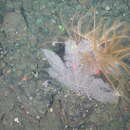en
names in breadcrumbs


“24. Plumarella Gray, 1870
FIGURE 11K–S
Cricogorgia Milne Edwards, 1857:6, pl. B2, fig. 6 [nomen nudum].
Plumarella Gray, 1870:36.—Studer, 1887:51.—Wright and Studer, 1889: xlix, 73–74.—Versluys, 1906:13–14.—Kinoshita, 1908a:6–8.—Kükenthal, 1915:144–145 [key to genus and species]; 1919:340–343 [key to genus and species]; 1924:255 [key to genus and species].—Deichmann, 1936:155 [key to genus].—Bayer, 1956:F220; 1961:293 [illustrated key to genus]; 1981b:936 [key to genus].—Bayer and Stefani, 1989:454 [key to genus].—Cairns and Bayer, 2004c:448–449 [key to western Atlantic species].
Diagnosis. Colonies uniplanar, often plumose, and usually pinnately branched in an alternating mannerm(e.g., type species); some species dichotomously branched. Calyces occur in an alternating biserial arrangement (e.g., type species) (Figure 11k) or, rarely, in an irregular fashion; calyces inclined upward or closely appressed (type species) to branch. Well-developed operculum present, the opercular scales smooth on their inner distal surface (not keeled) and tuberculate to smooth proximally; the operculars of the type species are uniquely shaped with a broad base and a very slender distal part (Figure 11o–p). The eight marginal scales do not fold over the operculars and have a variety of distal shapes, including serrate (type species), straight, pointed, and prominently spinose. Polyps protected by eight longitudinal rows of body wall scales, those on the adaxial side sometimes fewer in number (type species). Outer surfaces of sclerites smooth or slightly granular; inner surfaces tuberculate in regions where they overlap the outer surface of another sclerite (as in most primnoids). Coenenchymal sclerites in one layer of scales that are externally smooth or slightly granular (Figure 11n; type species).
Discussion. The 20 species in the genus are listed in Table 4. Characters used to distinguish species include shape of the distal edge of the opercular and marginal scales, number of scales in the abaxial body wall row, branching mode, and the sculpture on outer surface of scales. The type species, P. penna, differs from most of the species currently placed in the genus in several characters. Its opercular scales are uniquely shaped (Figure 11o–p) and so slender that they do not form a complete covering of the polyp; they articulate to form a fl at operculum over the polyp. The calyces are quite small (only 0.4 mm long and 0.25 mm in diameter) and are closely appressed to the branch, almost adnate, having only very short (two or three scales) adaxial rows of body wall scales. Coenenchymal scales are elongate and have coarse granules on their edges (Figure 11n). Finally, none of the sclerites appear to have tubercles on their inner surface, a character that blurs the distinction between Plumarella and Acanthoprimnoa.
Distribution. Western Pacific, Patagonia, northwest Atlantic, 10–1,914 m.
Type Species. Gorgonia penna Lamarck, 1815, by subsequent designation (Wright and Studer, 1889:73). Type deposited at MNHNP (fide Versluys, 1906:18) and a fragment of the type at the ZMA (Coel. 3085) (van Soest, 1979). The type species is well described and figured by Versluys (1906:18–20) and Fabricius and Alderslade (2001), the latter in color.”
(Bayer & Cairns, 2009)